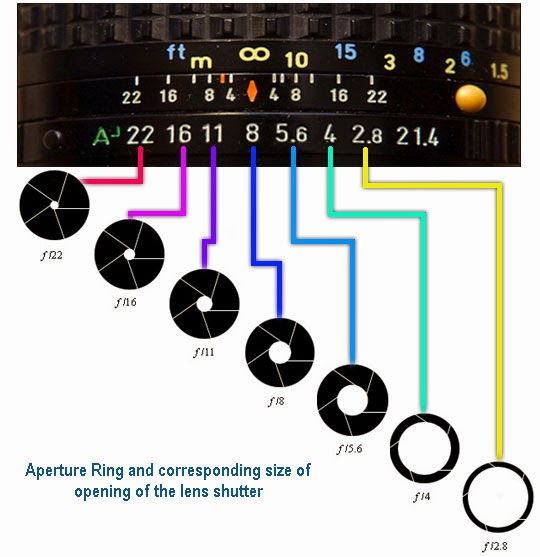Aperture is the opening in the lens through which light travels to reach the sensor. The size of the opening could be controlled by the photographer so as to let in more or less light as required. The amount that lens can open and close down is referred to as aperture and are listed as f numbers to quantitatively describe the relate size of the opening. It is also referred to as the diaphragm, the iris etc.
 |
| Camera Aperture |
F stop – the ratio of the focal length of the lens to the entrance pupil –or- the opening of the lens.
Typical ranges of apertures used in photography are
1 1.4 2 2.8 4 5.6 8 11 16 22 32 45 64 and maximum opening of lenses are always put as “1: the opening of the lens”.
The above table presents f stops in 1 full stop increments. Most cameras allow you to control f stops in 1/3rd stop increments for precision control however in this discussion we will stick to full stops to keep things simpler.
There is an easy method to remember f stop values; trick is to remember the numbers 1 and 1.4. If you write 1 and on the line below write 1.4 now write the doubles of those in the lines
1 2 4 8 16 32 64
1.4 2.8 5.6 11 22 45
Now if you combine both the lines
1 1.4 2 2.8 4 5.6 8 11 16 22 32 45 64
You get the aperture scale. It is quite possible to go beyond those numbers, like we have lenses that go beyond f 64 and also below f 1. But on a typical camera around f 1.4 to f 22 is the scale that you are likely to see.
If you observe closely you will find that larger opening are denoted by lower f numbers and smaller openings are denoted by larger f numbers. This is one aspect of photography that causes much confusion to the beginners.
If you could lay hands on a lens that has manual aperture dial (all old lenses do); hold it up, look through the lens and as you open and close the aperture, you will see that the size of the aperture opening changes to let in more or less light. When you move the aperture from f 2.8 to f 2 you are opening up the aperture by one full stop and thus have doubled the amount of light. And when you are going from f 2.8 to f 4 you are closing the aperture by one full stop there by cutting in half the amount of light passing through.
One thing you will notice is that the numbers are not doubling or cutting in half with each step because when you go from f 2.8 to f 2 the circle only gets a little bit bigger but it lets in twice as much light.
Size of the opening
 |
| Aperture |
You can figure out the size of the opening on any of your lenses using the formula focal length over the maximum f number.
So using this formula on a 50mm 1:1.4 lens, we get 50/1.4=35mm. if you set the lens to f/1.4 and measure across the opening of the lens it will be exactly 35mm.
Size of Opening across different focal lengths
If we compare the size of lens openings for lenses with different focal lengths set to the same f stop we will find that differ.
For example a 24mm lens with f/1.4 as its maximum aperture will have an opening of 17mm. remember on the 50mm lens it was 35mm. so a much smaller opening on a wider lens lets is the same quantity of light as a larger opening on a lens with a longer focal length it’s the focal length that makes all the difference. Now if we consider a 300mm f2.8 lens, it has a massive opening of 107mm but still lets in only less light then both the 50mm f 1.4 and the 24mm f 1.4.
 |
| Camera Lens Aperture |
The important thing you need to remember about aperture is that f 1.4 is a large opening and lets in a lot of light and f 22 is a much smaller opening and only lets in much less light. Thus it is now clear that aperture controls the amount of light it lets through the lens but there is more to aperture than just that, it also controls the depth of field in the picture.
NEXT: What is a Fast Lens?